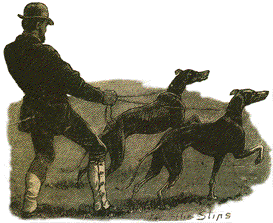HISTORY OF COURSING

Although humans have used
dogs for hunting for as long as recorded history exists (and evidence
supports their use way before then), coursing events as we know them today
were developed by open field coursing enthusiasts (National Open Field
Coursing Association) in the west and southwestern USA during the 60s
and 70s.
When faced with the facts that only a handful of states allowed pursuit of live game with dogs, and that urban encroachment and the limited supply of wild game would soon limit their sport, they searched for a suitable alternative. After some trial and error, they developed an artificial lure that would enable them to set up an imitation hunt that their dogs could enjoy without risking their safety (there are few wild animals, little rough terrain, and no barbed-wire fencing hazards on the modern day coursing field). They started with the idea of attaching a lure to a piece of moving string, and quickly adjusted the process to use a continual loop around pulleys driven with a motor.
The American Sighthound Field Association was formed in 1972. Some of the first lure coursing trials were held by ASFA and were open to Afghans, Borzoi, Greyhounds, Irish Wolfhounds, Salukis, Scottish Deerhounds, and Whippets. The eligible breeds were expanded to include Basenjis, Ibizan Hounds, Pharoh Hounds, and finally Rhodesian Ridgebacks. The American Kennel Club accepted lure coursing under its Performance Events Department in 1991, and both groups continue to sanction meets and trials today.